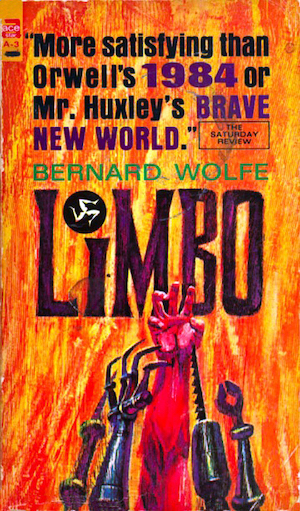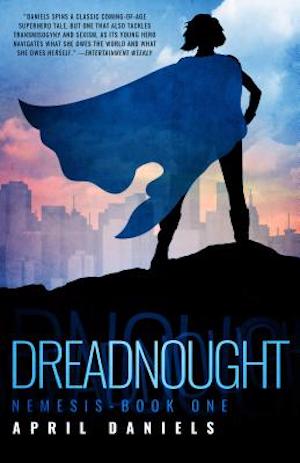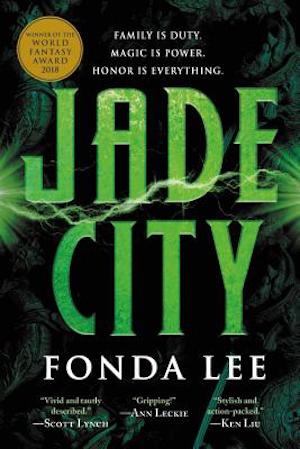An alternative to externally-mandated modification is, of course, self-directed modification. Who among us has not mused wistfully on how convenient it would be to replace our current eyes with functional sets, improve hearing, or simply acquire the ability to set people on fire just by thinking about it?
While modern technology does offer short-cuts for self-modification—glasses, hearing aids1, and microwave lasers tuned to the resonant frequency of water—these often fall short in one aspect or another. SFF authors can imagine far more potent methods to facilitate self-directed modification—in fact, as these five works show, they have!
Limbo by Bernard Wolfe (1952)

Dr. Martine flees World War III just before a hydrogen bomb obliterates the medical facility at which he worked. As far as the world knows, Dr. Martine is dead. In fact, he lives on an obscure island, providing its pacifist natives with lobotomies.
In 1990, the outside world intrudes on Dr. Martine’s refuge. He learns of his unexpected legacy: Dr. Martine’s notebook, filled with bitterly satirical musings, was used by the literal-minded Helder as the basis for the new world order. Peace and radical body-modification rule! Alas, the two remaining world powers disagree how best to achieve their shared goal. It seems there’s no way to save peace without launching World War Four…
While the world of 1990 is adept at replacing limbs, it lacks any way to compensate for excessive literal-mindedness or an inability to recognize satire. For that matter, there is no pill people can take to make them understand that the means they have chosen are opposed to their ends.2 I feel the author was trying to make some sort of point here.
War Games by Karl Hansen (1981)

Advanced biotechnology can transform baseline humans into beings that can survive hostile environments from Mars to Titan, and even the vacuum of space! Artificial biochemistries abound. Spaceships unbounded by mass ratios ply the space lanes. Human civilization has the means to spread across the galaxy. But rule by an immortal 0.000000001 percent of humanity means that humans are confined to the strife-torn Solar System.
Marc Detrs chased fortune using a precognitive timestone—instead, he glimpsed a graphic image of his eventual death. Ever cunning, Marc volunteered to become a Hybrid supersoldier in the endless war. Hybrids look nothing like the corpse he saw, so as long as Marc serves, no matter how dangerous the battlefield, he cannot be killed. By the time Marc realizes that timestones are adept at steering their users towards the very futures they seek to avoid, it’s far too late.
This novel requires a couple of content warnings. First: despite the publication date, it’s super-1970s. Second: while the characters embrace a wide range of sexual activity, the one nobody seems to be familiar with is “consensual.” Sex, like almost everything in this setting, is a means by which dominance is established.
Vigilant by James Alan Gardner (1999)

The Vigil is a constitutionally entrenched watchdog organization. The Vigil has comprehensive powers to monitor and report on all government activities, no matter how secret. The Vigil’s members can be trusted to uphold the public good not merely because they are carefully selected and rigorously trained. All members of the Vigil embrace the Mushor, a cognitive enhancement that makes it impossible for them to ignore unpleasant or inconvenient facts.
Murder being nearly unknown in the League of Peoples, Vigil member Faye Smallwood’s work should involve petty corruption, incompetence, and the like. However, not only does Faye find herself investigating a murder, the killer is targeting the Vigil. Faye must catch a killer or become the next victim herself.
Some readers may notice a parallel between the Mushor and the drug featured in John Brunner’s The Stone That Never Came Down (if you’ve not heard of it, see footnote two). This is not a case of Did We ALL Write a Book About Space Elevators? Gardner cites Brunner’s novel as inspiration in Vigilante’s acknowledgements.
Dreadnought by April Daniels (2017)

In superhero universes, marvelous transformation is as easy as chanting Shazam!, Kimota!, or striking a mystically-changed cane against the ground. Danny’s transformation began when Danny encountered a mortally wounded superhero. The mantle of power was passed from the dying Dreadnought to Danny.3 In an instant, Danny was transformed into an idealized superhuman: invulnerable, super-strong, able to fly, and—a detail that would enrage Danny’s bigoted father—manifestly a young woman rather than the teenaged boy Danny’s father believed Danny to be.
With great power comes great complications. The late Dreadnought’s teammates are unsure what to make of the new Dreadnought. Danny discovers that transformation provides no immunity to social bullying. Not to mention the fact that the person who killed the old Dreadnought may well decide to eliminate Danny as well … and that person had no trouble killing the previous Dreadnought, who was considerably more experienced.
Granted, being imbued with the mantle of power is largely an accident, but one that could only happen because Danny did not abandon a dying superhero. As well, what individual Dreadnoughts make of their abilities is entirely up to each individual.
Jade City by Fonda Lee (2017)

In a world not unlike our own, obtaining superhuman strength, speed, durability and other marvelous abilities is as easy as strapping on a bit of jade. Neither nephrite nor jadeite, this wonderous mineral imbues the wearer with nigh-superhuman abilities. Many jade-wearers subsequently discover that their bodies and minds cannot survive enhancement … but hey, no risk no gain!
The island nation Kekon is the sole source of natural jade. Foreign powers covet Kekon’s resources. While jade-enhanced Green Bones have successfully prevented foreigners from conquering Kekon, the quarrelsome warriors have also forestalled effective unification. Visionary clan leader Ayt Mada has a plan to bring the island under her leadership…but unfortunately for Ayt, she isn’t the protagonist. Kaul siblings Lanshinwan, Hiloshudon, and Shaelinsan are, and they are utterly opposed to Ayt.
Some readers may find it odd that Kekon is both the only place with jade and the only nation with a significant fraction of its population about to survive long-term exposure to jade. The two could be connected: on an island where exposure to jade is common, natural selection may have eliminated the most vulnerable.
***
As previous forays into this subject make clear, many science fiction and fantasy authors find self-directed enhancement inspirational. Examples abound, far more than the canonical five. Many works that would qualify for inclusion were not mentioned. Have fun pointing out my oversights in comments below!
In the words of fanfiction author Musty181, four-time Hugo finalist, prolific book reviewer, and perennial Darwin Award nominee James Davis Nicoll “looks like a default mii with glasses.” His work has appeared in Interzone, Publishers Weekly and Romantic Times as well as on his own websites, James Nicoll Reviews (where he is assisted by editor Karen Lofstrom and web person Adrienne L. Travis) and the 2021, 2022, and 2023 Aurora Award finalist Young People Read Old SFF (where he is assisted by web person Adrienne L. Travis). His Patreon can be found here.
[1]Which are of little help if the issue is complete loss of hearing in specific frequencies due to proximity to explosions.
[2]“The Stone That Never Came Down” by John Brunner focuses on such a pill. Implementation is done without the knowledge or consent of the subject, so it does not quite fit the theme of this essay.
[3]I am reminded of Lois Bujold’s Penric, who acquires trained temple demon (and thus becomes a sorcerer) when he stops to succor a dying temple divine.











I thought, Gosh, Vigilant sounds like something I might like to read. Then I discovered that, thanks to an earlier review by you, I had purchased The League of Peoples Books 1-3 and already read it.
“Old Man’s War” where the entire body is replaced with one optimized for soldiering and, if you survive your enlistment, replaced with a new normal body. Not sure if Scalzi ever explored the functional immortality this provides.
As someone who can neither see (due to a playground disagreement at 11 resulting in a scar on the retina of one eye) or hear (due to random loss of some frequencies in the opposite ear) stereo particularly well (if I lose a limb you can call me Lucky!) I pay attention to works that may allow me to replace my eyes and inner ears.
I recently read Neptune’s Brood by Charles Stross, in which the galaxy is populated by advanced metahuman androids who can alter their bodies (at will, to some extent, although more drastic changes require advanced surgery) and it’s standard to transform yourself to suit the environment as needed.
1: There’s always Jim’s Commitment Hour (same setting, but on Earth, and where people alternate between genders as kids) and his two superhero novels, All Those Explosions Were Someone Else’s Fault and They Promised Me the Gun Wasn’t Loaded.
Is it worth mentioning “The Barbie Murders” by John Varley? (Part of his revised/second Eight Worlds sequence.)
The body mods aren’t exactly compulsory … unless you want to live in the Barbie Colony, in which case they’re mandatory, as our detective protagonist discovers when she has to go undercover to find a murderer. But how do you find a murderer in a city of identical Barbies?
(Caveat: PCR amplification allowing DNA fingerprinting as a forensic technique hadn’t been invented when Varley wrote this novella. And given the Eight Worlds super-tech setting it might not work anyway.)
6: I will die on the hill that the Bach stories are not and cannot be reconciled with Eight Worlds, V1. That said, for everyone but Bach, the alterations are voluntary. As well, the Eight Worlds itself would count as a separate example.
Charles Sheffield had a rather wacky setting in which simple biofeedback conferred form change. I’ve only read the first one, Sight of Proteus.
Babel-17 by Delany has extensive (ornamental?) body modification, mostly used by non-respectable people.
As I recall, murder isn’t just rare in the Gardner books, interstellar travel is controlled by aliens who forbid anyone who’s killed (maybe just killed deliberately) from interstellar travel. This presumably makes interstellar war much less likely.
Beyond The Barbie Murders, Varley’s Eight Worlds had lots of body modification. Going on vacation?- modify your body to fit!
Becky Chambers’ To Be Taught if Fortunate has space explorers modifying themselves to explore various planets. Her Wayfarers series has lots of body-modifying tech, some medical, and some ‘because I want it.’
There’s also the shaper/mechanist stories by Bruce Sterling. Opposing societies, one focused on genetic manipulation and the other with cybernetic implants working to colonize our solar system.
There’s also Eileen Gunn’s “Stable Strategies for Middle Management” (June 1988 Issac Asimov’s Science Fiction Magazine, later included in The Year’s Best Science Fiction: Sixth Annual Collection edited by the late Gardner Dozois) where corporate office workers bioengineer themselves into human/insect hybrids to better fit the company “hive”. Not just social insects either: the protagonist, er, “resolves” a dispute with her boss by employing a strategy borrowed from the preying mantis…
I expected to see Man Plus on your list.
I first read Limbo around 1980, and have been wanting to re-read it ever since.
I didn’t really care for Man Plus in the 1970s and have not reread it in the last 40 years.
James: 6: I will die on the hill that the Bach stories are not and cannot be reconciled with Eight Worlds, V1.
Then you are in violent agreement with their author, who has explicitly said as much in at least one essay I remember reading (but can’t recall where—in one of his more recent short story collections, I think).
In The Moon Is a Harsh Mistress, the narrator lost a forearm in a laser-drilling accident; he now has an assortment which he can swap in for jobs needing strength, fine manipulation, …
Since you didn’t specify human modifications: in “Q.U.R.”, an offbeat genius realizes that defaulting to building robots as imitation humans and then assigning them limited/specialized jobs is driving them crazy; he ~augments some (e.g. a soldier-bot with a pistol in place of a hand, so the pistol never gets stuck in its holster) and reduces others to essentials (an air-traffic controller becomes a voicebox and one arm), but all are a lot happier afterward. (I don’t think Boucher was thinking of human analogies….)
Voluntary modifications need not be augmentations even in humans; one Varley character gets fed up with sexual maneuvering and adopts a form with no sex characteristics/organs, while the Skoptsy colony in The Stars My Destination removes not only sex characteristics (like the Russian originals) but all the senses.
Ray Bradbury’s “The Watchful Poker Chip of M. Matisse” involves purely decorative modifications to seem hip; IIRC, some start by making a body part unrecoverable after an accidental loss (e.g., he kicks a cut-off fingertip into a storm drain). More like contemporary satire than SF, but it shows up in ISFDB like other borderline work (e.g. “The Wonderful Ice Cream Suit”).
Obviously, pretty much everyone in Iain M Banks’s Culture novels.
An oddly relevant story to this concept is the “Transformations” arc of Bernard “Goldfur” Doove’s Forest Tales: A terrorist’s bomb damages a transporter while it is in use, saving Dale Perkins’s life results in him having an unplanned species, (and sex), reassignment.
While this particular body modification was unintended¹, the incident isn’t simply forgotten within the setting. It wouldn’t be too long before the “Oceanwalker Process” enters clinical trials as a way for people to get a new body.
(Points of fair warning: First, it’s furry, including not one but two cat-like alien species². Second, since it’s a chakat story, you can expect hermaphrodites having sex.)
1: And undesired by the Humans First terrorists.
2: Most morphs, and all the living centauroid ones, are the results of human genetic tinkering however.
Going way back, James Blish’s short story “Surface Tension.”
This is discussed in the book; the actual native people of the island are completely unaffected by jade, the Kekonese are descendants of them and the first colonial power to take the island, so they’re mostly immune enough to not always go mad and die from using jade, but susceptible enough to get powers from it.
The Neil Gaiman short story “Angels” has a cancer cure that changes the patient’s sex. This becomes a recreational drug and “change” becomes a dirty word due to moral panic. Eventually gender doesn’t matter and people become the angels of the title.
Antibodies by David J. Skal is about a body mod cult. It’s terrifying.
Oh hey here’s one I can add one of mine to – “A Dragon in Two Parts”, published in Escape Pod, is about body modification by choice.
https://escapepod.org/2021/12/30/escape-pod-817-a-dragon-in-two-parts/
Does modifying one’s body chemistry so that one can’t accidentally conceive count as a body mod? I mean, we sort of do that now with birth control pills and so on, but I was thinking of Dreamsnake biofeedback sort of stuff.
Sentenced to Prism by Alan Dean Foster fits in here and remains one of my favorite books. Yeah, it is a little (or a lot) light compared to the other books on the list, but I have always loved the main character’s reaction to the modifications. Total panic seemed completely appropriate.
I have to say Nova, by Samuel Delany. It’s an a amazing book you need to read.
The story “Diamond Dogs” by Alastair Reynolds, where persons trim their bodies, to fit in ever smaller rooms, to reach the target in a mysterious spire, that asks mathematical riddles to solve for access to the next room.
I am going to bring it back to Anne McCaffrey’s Brainship series with The Ship Who Searched. This time, instead of a baby born deformed and turned into a brainship without consent, it is en extremely precocious little girl who has contracted an alien virus that left her completely paralyzed from the neck down – and she talks her way into becoming the oldest brainship candidate ever. Since she’s already trapped in her own body, she argues for being able to replace sensation with sensors, and restore mobility with rockets. She later goes on to design a mechanical body that she can inhabit for more personal interactions, since she is unusual among brainships in that she remembers having that mobility from before.
Ashok, a member of the rag-tag spaceship crew that saves the day in Tim Pratt’s Axiom series. Here’s how that character is described in an online reference I just found:
“Mechanic Ashok is an enhanced post-human with a cheerful (some would say suicidally enthusiastic) look on life and his human body being augmented by cybernetic parts.”
https://www.sffworld.com/2018/07/the-wrong-stars-by-tim-pratt/ (although he’s not just a “mechanic” but rather the ship’s brilliant engineer).
Tanith Lee’s Don’t Bite The Sun & its sequel Drinking Sapphire Wine.
The novelette “The Girl-Thing Who Went Out for Sushi” by Pat Cadigan.
In Cordwainer Smith’s “Instrumentality of Mankind” future history, there are those who undergo cyborg-type implants, such as Scanners, Go-Captains, Pinlighters, and others, in order to pilot spacecraft. There is also mention in one story, “Golden the Ship Was, Oh, Oh, Oh,” of having a “port” inserted so that one can plug current directly into the pleasure centers of the brain.
“The Body Scout” by Lincoln Michel is all about body modifications, from cosmetic to complete rebuilding for specific purposes – the protagonist is a talent scout for a sports league of genetically/physically modified athletes. The book is also an indictment of capitalism where people who run behind on payments are likely to have body parts repossessed.
If we’re including nonhumans doing voluntary bodymod, Martha Wells’s Murderbot series – the second novel, Artificial Condition, features the main character changing the length of their limbs as well as some other modifications so that they can blend in with humans better.
What about the *Uglies* series by Scott Westerfeld! It’s YA scifi and brilliant. In a not-too-distant future, teenagers receive a total body makeover, turning them into Pretties. The Uglies are even segregated from the Pretties! I’ve reread that series many times over!
Meljean Brook’s steampunk/romance Iron Duke series is chock full of characters with modifications, from everyday seamstresses with sewing machine limbs to a flesh-like nanobot material.
also Simon Green’s Deathstalker is kind of modified…
I’ll toss “Superluminal” by Vonda McIntyre into the body-mod ring. Pilots of superluminal ships replace their cardiopulmonary systems so they aren’t locked into a biological rhythm when navigating hyperspace. And you can reprogram your own genetics to gain things like infrared vision by just infecting yourself with a designer virus.
A few that come to mind:
Kim Stanley Robinson includes body modification in both Green Mars and 2312 (maybe others but I don’t remember)
Nnedi Okorafor includes it in some of her books.
Octavia Butler’s Xenogenesis series.
Joan Slonczewski’s Elysium Cycle.
The inhabitants of planet Valedon can change their looks, their biological age, and even their gender at a whim, thanks to nanotechnology.
Its moon, Shora, is home to two completely modified societies, voluntarily modified from Earth stock: one of amphibious women who live mostly underwater, and another of long-lived “elves” who retain both genders and live in floating cities. Both societies reproduce asexually.
John Varley’s Steel Beach. I think others mention the Eight World Series of which this is the first I think. Gender reassignment is quite common and complete, meaning a man will have ovaries, etc. humans also alter themselves for ease of space travel, read the Ophiuchi Hotline.
Dan Simmons Ilium and Olympos feature “Greek gods” who are really enhanced humans.
Generations before the other events in Fritz Leiber’s The Silver Eggheads, 30 writers accepted an offer of immortality that involved them being reduced to brains-in-cans (egg-shaped cans, for IIRC unexplained reasons). They’re called on when real writers no longer exist, although the results (after all that time in effective isolation) aren’t great.
@39: Do they live in Schenectady?
A list about body transformations without Jack L Chalker?!?
4. I think someone promised Alec Baldwin that…
The Greg Bear novels Queen of Angels and Slant involve nanotechnology that allows humans to modify their bodies at a cellular level.
Kelly Robson’s Gods, Monsters and the Lucky Peach has intentional body mods allowing people to travel into the past.
@24 I was hoping someone would mention Nova. I still consider it one of Delany’s best novels. It gets far too little love. I enjoyed his take on the body mods; spacers modify themselves, adding claws, horns, tusks, wings—all to gain advantage in gladiatorial trials that serve as job applications. This is still the first novel my brain goes to at the suggestion of deliberate body modification.
Okay I squealed a little, to see Vigilant pop up. Still one of the best League of Peoples books, love love love. The handling of pandemic psychology is pretty good too, the use of Festina was wonderful. The natural group marriages and all too, just. Good solid character scifi hidden by the apparent pop scifi style.
I saw commitment hour mentioned… oh god. I love that book, but. But. The Shylock style villain makes it hard to recommend without a bit of careful discussion (they ARE sympathetic, like Shylock, but… do horrible things), but look. I’m a twin. And figured out oops gender issues at freaking 37. I was always baffled, the way main character didn’t just choose girl. It seemed better for him across the board.
did no one mention A Miracle of Rare Design by Mike Resnick?
Voluntary body modifications appeared very tempting in CJ Cherryh’s Hammerfall and Forge of Heaven. I think one side character modified her pupils to look like stars?
The involuntary infection of others with nano’s on the other hand, wasn’t so agreeable.
5) I just read “The Barbie Murders” and PCR would probably not help. The bodies aren’t identical, even without DNA, just very, very similar, but that doesn’t help you pick someone out of a lineup, or even chase them through a crowd. If you got a DNA sample you knew was from the killer you would be able to identify them – but the Barbies don’t have fixed homes or workplaces, and all the clothing fits any one of them, getting such a sample is tricky.
In Joe Haldeman’s “None So Blind” an easy bit of surgery can make anyone super smart. It’s voluntary, but there are some economic pressures pushing people into it.
@14: Hmm. That’s Ray Bradbury in 1954, was re-attaching severed body parts a thing then? A page from NPR says that “plastic surgery” existed as word since 1798, and people wounded in the American Civil War and First World War benefitted… oh, and the first successful organ transplant, a kidney, was in 1954 in fact. So I suppose the other thing comes somewhere between those dates. I think the Civil War was before safe surgery of any kind.
@50: It varied. I remember a big to-do in news in IIRC the very early 1960’s, about the reattachment of an arm that had been ripped off a kid who was hanging off the side of a freight car when it passed something that just cleared the cars — but that was a whole arm, not a fingertip (and half of the luck was that he didn’t bleed out…).
@40: I see what you did there — but they lived in a large city called New Angeles, California. OTOH, taking a trip anywhere would have improved their work….
Response to Robert Carnegie Post #50. Hello Robert, surgery was very common by the 1860’s as Anesthesia was developed in the 1840’s. Despite a death rate of approx 1 in 600 ( modern rate about 1 in 200,000) it was preferable to death or disfigurement.
Some Civil War historians believe that Confederate raids on Union supply trains were to steal ether and chloroform, not gold.
Keith E. [Anesthetist x 42 years]
@45, you’re thinking of Babel-17 – another great delany space opera! Nova has some body modification, but more in the realm of conventional-ish prosthetics (don’t mention the hand!) than the wild variety that different spacers have in Babel-17.
@52: I was thinking of surgery hygiene and its consequences. I think that came a bit later – Wikipedia on Joseph Lister is a very long web page, but it seems to get to cleaning the operating theatre in around the year 1865.
Amazing! An entire thread without mentioning Gully Foyle in The Stars My Destination.